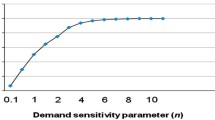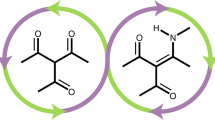Abstract
This paper addresses a procurement issue facing a polystyrene packaging manufacturer considering its optimal purchasing strategies between two suppliers—one providing virgin material, the other offering recycled material. We model a single-period scenario where each supplier sells product with a known yield distribution at market pricing. The manufacturer must choose whether to sole-source or dual-source, as well as determine how much material to purchase from each supplier to meet deterministic demand. Our results indicate that there is a range of prices from the recycled material supplier where dual-sourcing will lead to higher manufacturer profits compared to sole-sourcing. We show, based on the procurement strategy, the optimal quantities to purchase to maximize manufacturer’s expected profit.







Similar content being viewed by others
References
Agrawal, N., & Nahmias, S. (1997). Rationalization of the supplier base in the presence of yield uncertainty. Production and Operations Management, 6, 291–308.
Anupindi, R., & Akella, R. (1993). Diversification under supply uncertainty. Management Science, 39, 944–963.
Aras, N., Boyaci, T., & Verter, V. (2006). Coordination and priority decisions in hybrid manufacturing/remanufacturing systems. Production Operations Management, 15, 528–543.
Dada, M., Petruzzi, N., & Schwarz, L. (2007). A newsvendor’s procurement problem when suppliers are unreliable. Manufacturing and Service Operations Management, 9, 9–32.
EPA. (2013). Municipal solid waste generation, recycling, and disposal in the United States: Facts and figures for 2010. http://www.epa.gov/wastes/nonhaz/municipal/pubs/msw_2010_rev_factsheet.pdf
Ferguson, M., Guide, V. D., Koca, E., & Souza, G. (2009). The value of quality grading in remanufacturing. Production and Operations Management, 18, 300–314.
Gerchak, Y., & Parlar, M. (1990). Yield randomness, cost trade-offs and diversification in the EOQ model. Naval Research Logistics, 37, 341–354.
Geyer, R., Van Wassenhove, L., & Atasu, A. (2007). The economics of remanufacturing under limited component durability and finite product life cycles. Management Science, 53, 88–100.
Giri, B. C. (2011). Managing inventory with two suppliers under yield uncertainty and risk aversion. International Journal of Production Economics, 133(1), 80–85.
Guide, V. D., Jayaraman, V., Srivastava, R., & Benton, W. (2000). Supply-chain management for recoverable manufacturing systems. Interfaces, 30, 125–142.
Guide, V. D., & Srivastava, R. (1998). Inventory buffers in recoverable manufacturing. Journal of Operations Management, 16, 551–568.
Guide, V. D., Srivastava, R., & Kraus, M. (1997). Product structure complexity and scheduling of operations in recoverable manufacturing. International Journal of Production Research, 37, 3179–3199.
Guide, V. D., & Van Wassenhove, L. (2001). Managing product returns for remanufacturing. Production and Operations Management, 10, 142–155.
Gullu, R., Onol, E., & Erkip, N. (1999). Analysis of an inventory system under supply uncertainty. International Journal of Production Economics, 59(1), 377–385.
Gurler, U., & Parlar, M. (1997). An inventory problem with two randomly available suppliers. Operations Research, 45(6), 904–918.
Kouvelis, P., & Li, J. (2013). Offshore outsourcing, yield uncertainty, and contingency responses. Production and Operations Management, 22, 164–177.
Lund, R. T. (1993). The American edge: Leveraging manufacturing’s hidden assets. New York: McGraw-Hill.
Mississippi Department of Environmental Quality. (2013). Recycling trivia. http://www.deq.state.ms.us/mdeq.nsf/page/Recycling_RecyclingTrivia?OpenDocument
Nasr, N., Hughson, C., Varel, E., & Bauer, R. (1998). State of the art assessment of remanufacturing. In Tech. rep., National Center for Remanufacturing and Resource Recovery, Rochester, NY.
Ozekici, S., & Parlar, M. (1999). Inventory models with unreliable suppliersin a random environment. Annals of Operations Research, 91, 123–136.
Parlar, M., & Berkin, D. (1991). Future supply uncertainty in EOQ models. Naval Research Logistics, 38(1), 107–121.
Parlar, M., & Perry, D. (1996). Inventory models of future supply uncertainty with single and multiple suppliers. Naval Research Logistics, 43(2), 191–210.
Parlar, M., & Wang, D. (1993). Diversification under yield randomness in inventory models. European Journal of Operations Research, 66, 52–64.
Pokharel, S., & Mutha, A. (2009). Perspectives in reverse logistics: A review. Resources, Conservation and Recycling, 53, 175–182.
Schmitt, A. J., & Snyder, L. V. (2012). Infinite-horizon models for inventory control under yielduncertainty and disruptions. Computers and Operations Research, 39, 850–862.
Swaminathan, J. M., & Shanthikumar, J. G. (1999). Supplier diversification: Effect of discrete demand. Operations Research Letters, 24, 213–221.
Tang, S. Y., & Kouvelis, P. (2011). Supplier diversification strategies in the presence of yield uncertainty and buyer competition. Manufacturing and Service Operations Management, 13(4), 439–451.
Thierry, M., Salomon, M., Van Nunen, J., & Van Wassenhove, L. (1995). Strategic issues in product recovery management. California Management Review, 37, 114–135.
Yano, C., & Lee, H. (1995). Lot sizing with random yield: A review. Operations Research, 43, 311–334.
Author information
Authors and Affiliations
Corresponding author
Appendices
Appendix 1: Proof of property 1
Proof of concavity for the sole -sourcing expected profit functions (second order conditions):
-
1.
Sole-Sourcing with Supplier A Given \(X_{A}, D, C, R, S, a, b>0; a<b; S<R\) and Eqs. (5) and (6):
$$\begin{aligned}&\frac{\partial ^{2} E[\Pi _{A}]}{\partial X_{A}^{2}}=-\frac{D^{2}(C+R-S)}{(b-a)X_{A}^{3}} \\&D^2(C+R-S)>0 \text { and } (b-a)X_{A}^3>0 \\&\therefore \frac{\partial ^{2} E[\Pi _{A}]}{\partial X_{A}^{2}}<0, \text { so } E[\Pi _{A}] \text { is strictly concave.} \end{aligned}$$ -
2.
Sole-Sourcing with Supplier B Given \(X_{B}, D, C, R, S, c, d>0; c<d; S<R\) and Eqs. (9) and (10):
$$\begin{aligned}&\frac{\partial ^{2} E[\Pi _{B}]}{\partial X_{B}^{2}}=-\frac{D^{2}(C+R-S)}{(d-c)X_{B}^{3}} \\&D^2(C+R-S)>0 \text { and } (d-c)X_{B}^3>0 \\&\therefore \frac{\partial ^{2} E[\Pi _{B}]}{\partial X_{B}^{2}}<0, \text { so } E[\Pi _{B}] \text { is strictly concave.} \end{aligned}$$
Appendix 2: Proof of property 2
Proving the continuity of \(E[\Pi _{AB}]\) only requires substituting the boundary conditions into the profit functions of the corresponding cases as follows:
-
When \(D=aX_A+dX_B\) and \(D=bX_A+cX_B\) then \(E[\Pi ^{I}_{AB}]\) = \(E[\Pi ^{II}_{AB}]\) = \(E[\Pi ^{III}_{AB}]\) = \(E[\Pi ^{IV}_{AB}]\).
-
When \(D=aX_A+dX_B\) and \(D<bX_A+cX_B\) then \(E[\Pi ^{I}_{AB}]\) = \(E[\Pi ^{III}_{AB}]\).
-
When \(D>aX_A+dX_B\) and \(D=bX_A+cX_B\) then \(E[\Pi ^{I}_{AB}]\) = \(E[\Pi ^{IV}_{AB}]\).
-
When \(D<aX_A+dX_B\) and \(D=bX_A+cX_B\) then \(E[\Pi ^{II}_{AB}]\) = \(E[\Pi ^{III}_{AB}]\).
-
When \(D=aX_A+dX_B\) and \(D>bX_A+cX_B\) then \(E[\Pi ^{II}_{AB}]\) = \(E[\Pi ^{IV}_{AB}]\).
To prove that the expected profit functions \(E[\Pi ^{i}_{AB}]\) for \(i=I,II,III,IV\) are strictly concave, the second order conditions and the following optimality conditions will be utilized.
Since \(0<S<p_B<p_A<R\), it is never optimal to always overstock. In other words, the following is an optimality condition for this problem:
Also note that it is never optimal to always understock. In other words, the following is another optimality condition for this problem:
Given \(X_{A}, X_{B}, D, C, R, S, a, b, c, d>0; c<d<a<b; S<R\), we show that the Hessian is negative definite.
Case I: The second-order partial derivatives of \(E\left[ \Pi _{AB}\right] \) under Case I are as follows:
Thus, the determinant of the Hessian = \(\frac{D^2(d-c)^2(C+R-S)^{2}}{12X_{A}^4(b-a)^2}\). Note the following observations:
-
1.
The second leading principal minor is negative (i.e., \(\frac{\partial ^2 E\left[ \Pi ^{I}_{AB}\right] }{\partial X_{B}^2}<0)\).
-
2.
The determinant of the Hessian is positive (i.e., \(\frac{\partial ^2 E\left[ \Pi ^{I}_{AB}\right] }{\partial X_{A}^2}\frac{\partial ^2 E\left[ \Pi ^{I}_{AB}\right] }{\partial X_{B}^2}-(\frac{\partial ^2 E\left[ \Pi ^{I}_{AB}\right] }{\partial X_{B} \partial X_{A}})^{2}>0)\).
-
3.
Items (1) and (2) above imply that the first leading principal minor is negative (i.e., \(\frac{\partial ^2 E\left[ \Pi ^{I}_{AB}\right] }{\partial X_{A}^2}<0)\).
-
4.
From items (1), (2), and (3) we can conclude that \(E[\Pi ^{I}_{AB}]\) is strictly concave.
Case II: The second-order partial derivatives of \(E\left[ \Pi _{AB}\right] \) under Case II are as follows:
Thus, the determinant of the Hessian \(=\frac{D^2(b-a)^2(C+R-S)^{2}}{12X_{B}^4(d-c)^2}\). Note the following observations:
-
1.
The first leading principal minor is negative (i.e., \(\frac{\partial ^2 E\left[ \Pi ^{II}_{AB}\right] }{\partial X_{A}^2}<0)\).
-
2.
The determinant of the Hessian is positive (i.e., \(\frac{\partial ^2 E\left[ \Pi ^{II}_{AB}\right] }{\partial X_{A}^2}\frac{\partial ^2 E\left[ \Pi ^{II}_{AB}\right] }{\partial X_{B}^2}-(\frac{\partial ^2 E\left[ \Pi ^{II}_{AB}\right] }{\partial X_{B} \partial X_{A}})^{2}>0)\).
-
3.
Items (1) and (2) above imply that the second leading principal minor is negative (i.e., \(\frac{\partial ^2 E\left[ \Pi ^{II}_{AB}\right] }{\partial X_{B}^2}<0)\).
-
4.
From items (1), (2), and (3) we can conclude that \(E[\Pi ^{II}_{AB}]\) is strictly concave.
Case III: The second-order partial derivatives of \(\Pi _{AB}\) under Case III are as follows:
Thus, the determinant of the Hessian \(=\frac{D^2(C+R-S)^2(aX_{A}+cX_{B}-D)^4}{12X_{A}^4X_{B}^4(b-a)^2(d-c)^2}\). Note the following observations:
-
1.
Under Eq. (25) the first leading principal minor is negative (i.e., \(\frac{\partial ^2 E\left[ \Pi ^{III}_{AB}\right] }{\partial X_{A}^2}<0)\).
-
2.
Using (25) it is also easy to show that second leading principal minor is negative (i.e., \(\frac{\partial ^2 E\left[ \Pi ^{III}_{AB}\right] }{\partial X_{B}^2}<0)\).
-
3.
The determinant of the Hessian is positive.
-
4.
From items (1), (2), and (3) we can conclude that \(E[\Pi ^{III}_{AB}]\) is strictly concave.
Case IV: The second-order partial derivatives of \(\Pi _{AB}\) under Case IV are as follows:
Thus, the determinant of the Hessian = \(\frac{D^2(C+R-S)^2(bX_{A}+dX_{B}-D)^4}{12X_{A}^4X_{B}^4(b-a)^2(d-c)^2}\). Note the following observations:
-
1.
Under Eq. (26) the first leading principal minor is negative (i.e., \(\frac{\partial ^2 E\left[ \Pi ^{IV}_{AB}\right] }{\partial X_{A}^2}<0)\).
-
2.
Using (26) it is also easy to show that second leading principal minor is negative (i.e., \(\frac{\partial ^2 E\left[ \Pi ^{IV}_{AB}\right] }{\partial X_{B}^2}<0)\).
-
3.
The determinant of the Hessian is positive.
-
4.
From items (1), (2), and (3) we can conclude that \(E[\Pi ^{IV}_{AB}]\) is strictly concave.
Rights and permissions
About this article
Cite this article
Rowe, P., Eksioglu, B. & Eksioglu, S. Recycling procurement strategies with variable yield suppliers. Ann Oper Res 249, 215–234 (2017). https://doi.org/10.1007/s10479-015-1872-y
Published:
Issue Date:
DOI: https://doi.org/10.1007/s10479-015-1872-y




